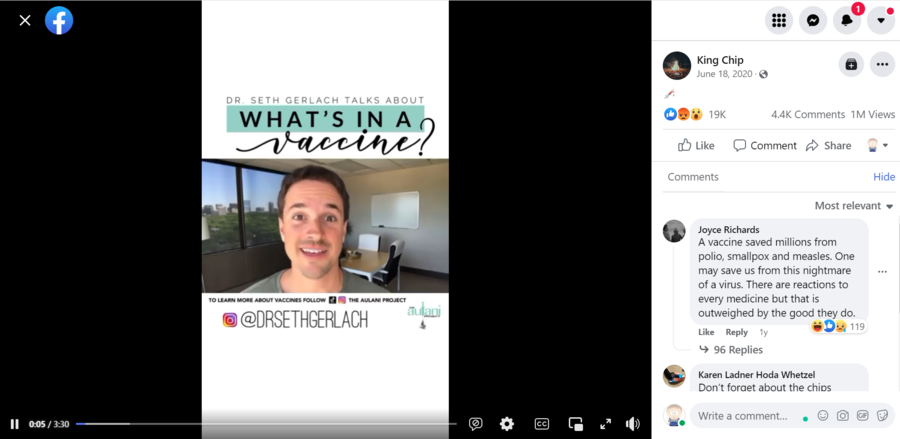
Are the ingredients put in vaccines toxic to people? No, that's not true: Before a vaccine is licensed by the Food and Drug Administration (FDA) and recommended for use by the Centers for Disease Control and Prevention (CDC) it's tested and evaluated in labs. While there are substances used in the production of the shots that are toxic to humans, the levels of those ingredients in the final products are minute.
The claims appeared in a video on Facebook on June 18, 2020. It opened:
DR. SETH GERLACH TALKS ABOUT WHAT'S IN A vaccine?
This is what the post looked like on Facebook on May 2, 2022:
(Source: Facebook screenshot taken on Mon May 2 20:11:47 2022 UTC)
The narrator
The three-minute, 30-second video is narrated by Seth Gerlach. Both his LinkedIn profile and the "About" page on his website say he received a doctorate of chiropractic from Logan College of Chiropractic, now Logan University.
Gerlach sets a sarcastic tone early with his vocal delivery that runs throughout the video. He begins by saying:
With all this talk about vaccines lately, I wanted to see exactly what they're putting in these vaccines to keep me healthy. Because vaccines make you healthy. So, I printed a list straight from the CDC to see what's going on in there. Let's take a look together. You want to?
The list
In all, Gerlach lists more than a dozen ingredients known as excipients that are found in very small amounts in vaccines. He doesn't specify, but his list of ingredients likely came from Appendix B of the CDC's Vaccine Excipient Summary, which includes a table of all the excipients found in vaccines available in the United States. His list covers many things that may sound scary or odd without additional explanation. While Gerlach provides little context and some misinformation about the ingredients, there's no shortage of editorial comments and knowing glances at the camera. Here's a sampling of what he says about some of the excipients in the video:
FD&C Yellow #6:
First off, yellow six -- the dye. Cuz, I don't want my vaccine to be not colored or anything. That would be boring.
Aluminum:
Aluminum, because I heard aluminum's really good for your brain and the more aluminum you have in the body in your brain the faster it works.
While aluminum salts are incorporated into some vaccine formulations, aluminum is not.
Formaldehyde:
Formaldehyde, because formaldehyde just shouldn't be for dead people. It should be for us, too. [Gerlach looks off camera] It causes cancer?
Preservatives:
Preservatives, because we want to be able to keep these vaccines on a shelf for many many years.
Antibiotics:
Antibiotics, because antibiotics in your bloodstream can never do anything bad to you.
Chicken protein:
Chicken protein. Who doesn't love chicken? I'll take those proteins all day.
This is found in one rabies vaccine. Many vaccine antigens are grown in animal and other proteins.
Thimerosal:
Thimerosal, because mercury can't be that bad for us, especially when they inject it. Right? [Gerlach looks off camera] Oh, it's the most toxic neurotoxin on the planet. Oh, should be fine.
The mercury found in thimerosal and the mercury found in the environment are not the same things. The mercury in thimerosal is broken down by the body differently and clears out of the blood more quickly, according to the FDA. Lead Stories previously debunked claims that thimerosal is linked to autism and that flu vaccines with the preservative contain more mercury than allowed in drinking water.
It's important to note that no single vaccine includes all these ingredients and some don't include any of them at all.
The explanation
This is how the CDC explains the use of excipients found in vaccines (Page 1):
Some excipients are added to a vaccine for a specific purpose. These include:
- Preservatives, to prevent contamination. For example, thimerosal.
- Adjuvants, to help stimulate a stronger immune response. For example, aluminum salts.
- Stabilizers, to keep the vaccine potent during transportation and storage. For example, sugars or gelatin.
Others are residual trace amounts of materials that were used during the manufacturing process and removed. These can include:
- Cell culture materials, used to grow the vaccine antigens. For example, egg protein, various culture media.
- Inactivating ingredients, used to kill viruses or inactivate toxins. For example, formaldehyde.
- Antibiotics, used to prevent contamination by bacteria. For example, neomycin.
In a May 6, 2020, article by Lead Stories, L.J. Tan, chief strategy officer for the Immunization Action Coalition, said the quantities of these excipients are minuscule:
'Those numbers are micrograms. They're not even milligrams,' he said. 'They're really small numbers.' [One microgram or mcg, by the way, is equal to one-thousandth, or 0.001, of a milligram or mg.]
Many of these same ingredients, Tan added, show up in the water we drink, food we eat and everyday products we use like hand lotion. If we don't have anything to compare it to, 801.6 mcg of formaldehyde sounds terrifying.
The truth about formaldehyde, according to ChemicalSafetyFacts.org, is this: It is 'a simple chemical compound made of hydrogen, oxygen and carbon. All life forms -- bacteria, plants, fish, animals and humans -- naturally produce formaldehyde as part of cell metabolism.'
Tan directed us to further details provided by the Vaccine Education Center at the Children's Hospital of Philadelphia. On a page dedicated to formaldehyde, the center states that the quantity of formaldehyde in a 2-month-old infant's blood is 'about 1,500 times more than the amount an infant would be exposed to in any individual vaccine.' Also included as proof of formaldehyde's safety in vaccines is this: 'Quantities of formaldehyde at least 600 times greater than the amount contained in vaccines have been fed safely to animals in drinking water.'
As another example, let's look at aluminum, which Tan said exists in breast milk and, even more so, in baby formula. In the first six months of life, he said, a breastfeeding baby ingests about seven milligrams -- or 7,000 mcg -- of aluminum, far more than what a baby would get in a vaccine.
The FDA, which licenses all vaccines in the United States, has a web page on Common Ingredients in U.S. Licensed Vaccines. It includes explanations on why they're included and what purposes they serve. It opens with this:
The vast majority of the over one billion doses of vaccines manufactured worldwide each year are given to healthy babies, children and adults. Thus, it is critical that vaccines be demonstrated to be safe and effective. FDA requires that vaccines undergo a rigorous and extensive development program in the laboratory, as well as in animal studies and human clinical trials, to determine their safety and effectiveness. Highly trained FDA scientists and clinicians carefully evaluate all of the information in a marketing application and make a determination whether to license (approve) a vaccine before it can be used in the United States. Prior to licensure, as part of FDA's evaluation, FDA takes all of the ingredients of a vaccine into account, including the active ingredients as well as other substances. After FDA approves a vaccine, FDA continuously monitors its safety.
















